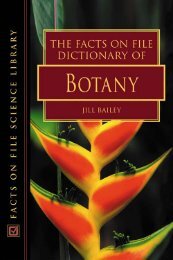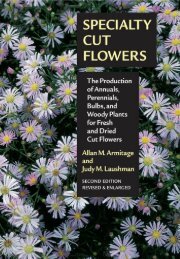You also want an ePaper? Increase the reach of your titles
YUMPU automatically turns print PDFs into web optimized ePapers that Google loves.
tube frequently corers the embryo sac via the<br />
micropyle (1.32) but in rare cases may directly<br />
penetrate the integuments. Once entry to the<br />
embryo sac has been gained, a pore forms near the<br />
tip of the pollen tube and the twO sperms 3re<br />
liberated. One sperm nucleus fuses with the egg<br />
nucleus and the other fertilises the centrallylocated<br />
polar nudei (1.32). In most flowering<br />
plants the cytoplasm surrounding the sperm nudei<br />
is not transmitted at fertilisation and therefore<br />
inheritance of chloroplasts and other organelles is<br />
generally via the female line.<br />
Development of the seed<br />
llltroduction<br />
The fertilisation of the haploid egg by a haploid<br />
sperm gives rise to a diploid zygote which<br />
subsequently divides repeatedly and develops in a<br />
highly organised manner into the embryo (1.33).<br />
The marure embryo commonly undergoes a period<br />
of dormancy within the protccri\'e seed coat (testa)<br />
which develops from the integuments of rhe<br />
cnlargencd ovule (1.33). The embryo is packed<br />
with food reserves (2.54); in albuminous seeds<br />
further food is stored in the mass of endosperm<br />
surrounding the embryo. In the Caryophyllaceae<br />
little endosperm is formed but the nucellus<br />
develops into a nutritive pcrisperm.<br />
Embryo development<br />
Following entry of the sperm nucleus through the<br />
wall-free region of the egg cell, a wall is secreted<br />
in this area of the zygote. Its nucleus then undergoes<br />
mitosis and usually a transverse wall divides<br />
the zygote into basal and terminal cells. The basal<br />
cell divides mainly transversely to form a suspensor<br />
(1.33); this pushes the terminal cell away from<br />
the micropyle and into the endosperm which is<br />
developing (1.33, 2.5, 8.37, 8.38) within the<br />
expanding embryo sac. In legumes the suspensor<br />
cells often show highly polyploid, amoeboid,<br />
nuclei (8.39) and apparently synthesise growth<br />
substances of importance for the development of<br />
the embryo. The terminal cell undergoes divisions<br />
in various planes to form a globular proembryo<br />
(8.38) and soon an outer layer of anticlinally<br />
dividing protoderm cells becomes established. In<br />
dicotyledons the enlarging globular procmbryo becomes<br />
transformed into a heart-shaped structure<br />
(1.33) as paired cotyledons at its chalazal end<br />
develop.<br />
The embryo now elongates and differentiation<br />
of the procambium and ground tissues occurs<br />
(8.40). The radicle apex becomes demarcated at<br />
the micropylar pole of the embryo and merges<br />
into the hypocotyl above (8.41). :\1eanwhile, at<br />
the other end of the hypocoryl and between the<br />
148<br />
cotyledons, a bulge representing the plumule<br />
becomes apparent. In the mature seed the<br />
plumular apex may either remain small (8.41) or<br />
is larger and has already given rise to its first<br />
foliage leaves (4.1, 8.42, 8.43), while the radicle<br />
shows a root cap and apex (8.44). Depending<br />
upon the architecture of the embryo sac the<br />
embryo may be straight or variously curved (1.33,<br />
8.41). In albuminous seeds abundant endosperm is<br />
present and the cotyledons are thin and leaf-like,<br />
in contrast to their swollen appearance in nonendospennous<br />
seeds (8.41, 8.42).<br />
In monocotyledons, the early development of<br />
the embryo parallels that in dicotyledons, but only<br />
a single lateral cotyledon is formed (1.21).<br />
Monocotyledonous seeds are commonly albuminous<br />
with the cotyledon apparently acting as a<br />
digestive organ. In palms the cotyledon often<br />
enlarges greatly and becomes haustoriaI, whilst in<br />
grasses the scutellum, which divides the endosperm<br />
from the embryo proper, is sometimes<br />
regarded as a modified cotyledon. During early<br />
germination the plumule of grasses is protected by<br />
a cylindrical leaf-like coleoptile while the radicle is<br />
initially ensheathed by the coleorhiza (8.45). In<br />
some flowering plams (begonias, orchids) the<br />
seeds are minute and the mature embryo shows<br />
little morphological differentiarioD_<br />
Endosperm<br />
In the majority of angiosperms two haploid pol:u<br />
nuclei occur in the embryo sac and their fusion<br />
with one of the sperm nuclei leads to the development<br />
of the triploid primary endosperm cell<br />
(1.32). However, in some species multiple polar<br />
nudei occur so that the resulting endosperm is<br />
polyploid. In a few species fertilisation of the<br />
polar nuclei does nOt occur and in others division<br />
of the primary endosperm nucleus ceases very<br />
early. In many albuminous seeds (8.43) the<br />
nuceJ1us and the inner imegument degenerate as<br />
the endosperm develops in the maruring seed.<br />
In most flowering plants the initial divisions of<br />
the primar}' endosperm nucleus are not followed<br />
by cytokinesis and a coenocytic nuclear endosperm<br />
develops (2.5, 8.37). However, subsequent<br />
free-wall formation leads to the celluJarisation of<br />
the endosperm (1.33, 8.32). These walls resemble<br />
those in some in vitro cultured tissues (2.62) and<br />
in conrrast to normal cell plate development<br />
neither microtubules nor Golgi bodies are<br />
apparenrly involved in their growth. The random<br />
wall formation results in some endosperm cells<br />
being multinucleate. In the mature fruit of Cocos<br />
(coconut, 8.46, 8.47) the watery milk of the<br />
enclosed seed represents the remnants of the<br />
coenocytic cytoplasm while the white flesh results<br />
from its cellularisation.





